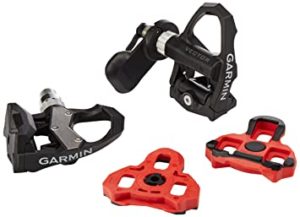Garmin Vector 2 versus 3 pedal power meters compared. Specifications of the power meters together with current best prices. Find the best pedal power meter for you.
Garmin Vector 2 Pedal Power Meter

The second generation of the Garmin Vector pedal power meter introduced dual sided or single sided data recording. The biggest change from the first generation power meter was the different power pod. You could now remove the pods without removing the pedals. Both Garmin Vector 1 & 2 were powered by flat CR32 cell style batteries.
The Garmin Vector 2 improved accuracy and quality of metrics. They were subject to less dropouts than the Garmin Vector 1’s and battery life improved slightly. One issue with the Vector 2’s was that because pods were thicker, they didn’t quite sit as flush with the cranks as the V1’s. This can lead to the electrical clip that fastened in behind the pedal itself to be broken during intensive cycling.
The Vector 2 is no longer available to buy new but there are plenty around on the second hand market.
Garmin Vector 2 Pedals Specifications
- Battery Life: Minimum of 175 hours of active cycling operation
- Battery type: User replaceable battery (2032 coin cell battery)
- Weight: Left pedal 179 grams / Right pedal 164 grams (total – 343 grams)
- Float: 6 degrees of float Data Transfer: Ant+
- Look Keo pedal compatible: Yes
- Construction: Lightweight composite body, stainless steel wearplate, anti-slip rubber surface pads
Garmin Vector 2 Full Review
Read our full review of the Garmin Vector 2 pedal power meter with essential information from long term testing.
Garmin Vector 3 Pedal Power Meter

The third generation of the Garmin Vector pedal power meter. The biggest difference you will notice is that there are no power pods, instead Garmin have managed to house the batteries and all the functionality inside the pedal body.
The Garmin Vector 3 power meter pedals are accurate, easy to use and pair rapidly with Zwift, Garmin watches and Garmin bike computers. Calibration is straight forward and requires minimal effort.
A further benefit of the Garmin Vector 3 is the ease of switching them between bikes. This means you can use them both on the TT bike that’s on the turbo one day and the next whilst you commute to work or go for ride out on the road bike. They can be swapped over and re-calibrated within a couple of minutes.
Garmin Vector 3 Pedals Specifications
- Battery Life: Minimum of 120 hours of active cycling operation
- Battery type: User Replaceable (LR44 / SR44 cell battery)
- Weight: 316 grams
- Float: 6 degrees of float
- Data Transfer: Ant+, Bluetooth
- Look Keo pedal compatible: Yes
- Construction: Lightweight composite body, stainless steel wearplate, anti-slip rubber surface pads
Garmin Vector 3 Full Review
Read our full review of the Garmin Vector 3 pedal power meter with essential information from one of the Trivelo team of associates.
Read some of our further articles on Power Meters
2023 Complete Buyers Guide to Power Meters with our recommendations on best Power Meters to buy.
5 Reasons Why you need a power meter to ride faster and get more scientific in your rides.
Are bike power meters worth it? Everything you need to know before buying a power meter.
Stages Dura-Ace crank based power meter review. Long term review from one of the Trivelo team of associates.
Powertap P1 pedal power meters. An alternative power meter to the Garmin Vector series of pedals.
Pedals are a likely consideration for any bike upgrade. But are clipless pedals worth the upgrade? We compare clipless pedals and flat pedals with the science behind differences. If you have resisted using clipless pedals to date you should read this post to help you make the right decision for you.



0 Comments